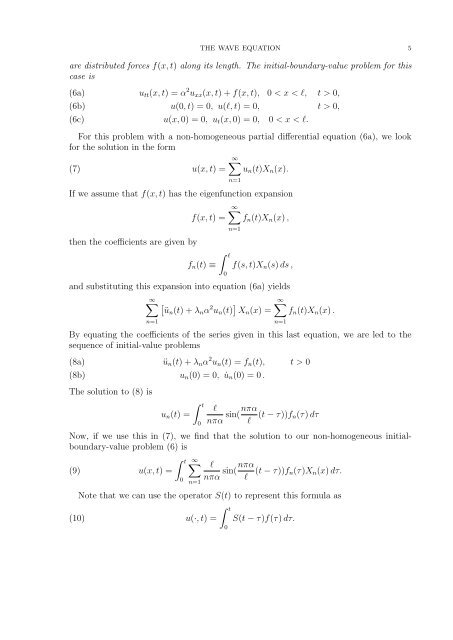4 R. E. SHOWALTERNote that if X(·) and T (·) are solutions of <strong>the</strong>se respective equations, <strong>the</strong>n it followsdirectly that <strong>the</strong>ir product is a solution (3a). <strong>We</strong> have already found <strong>the</strong> non-null solutionsof <strong>the</strong> boundary-value problem{X ′′ (x) + λX(x) = 0, 0 < x < l,(4)X(0) = 0, X(l) = 0.The solutions are <strong>the</strong> normalized eigenfunctionsX n (x) =√2l sin(nπ l x)corresponding to <strong>the</strong> eigenvalues λ n = (nπ/l) 2 . If we combine <strong>the</strong>se with <strong>the</strong> correspondingtime-dependent solutions cos(α √ λ n t) and sin(α √ λ n t) of <strong>the</strong> first differentialequation and take linear combinations, we obtain a large class of solutions of <strong>the</strong> partialdifferential equation (3a) and boundary conditions (3b) in <strong>the</strong> form of a seriesu(x, t) =∞∑ (An cos(α √ λ n t) + B n sin(α √ λ n t) ) X n (x),n=1where <strong>the</strong> sequences {A n } and {B n } are to be determined. From <strong>the</strong> initial conditions(3c), it follows that <strong>the</strong>se coefficients must satisfyso we obtain∞∑A n X n (x) = u 0 (x),n=1∞∑B n α √ λ n X n (x) = v 0 (x), 0 < x < l,n=1A m = (u 0 (·), X m (·)), B m = (v 0(·), X m (·))α √ λ m, m ≥ 1 .In summary, <strong>the</strong> solution of <strong>the</strong> initial-boundary-value problem (3) is given by <strong>the</strong> seriesu(x, t) =∞∑ ( √cos(α λn t)(u 0 (·), X n (·)) + sin(α √ λ n t) (v 0(·), X n (·))α √ )Xn (x).λ nn=1Denote <strong>the</strong> second term in <strong>the</strong> preceding formula by[S(t)v 0 ](x) =∞∑ ( √sin(α λn t) (v 0(·), X n (·))α √ )Xn (x).λ nn=1This defines <strong>the</strong> operator S(t) on <strong>the</strong> space of functions on [0, l]. <strong>We</strong> can use this operatorto represent <strong>the</strong> solution by(5) u(·, t) = S ′ (t)u 0 + S(t)v 0 .Example 2. Suppose <strong>the</strong> rod (0, l) is perfectly elastic and set α 2 = k ρ. Assume that bo<strong>the</strong>nds of <strong>the</strong> rod are fixed, <strong>the</strong> initial displacement and velocity are both null, and that <strong>the</strong>re
<strong>THE</strong> <strong>WAVE</strong> <strong>EQUATION</strong> 5are distributed forces f(x, t) along its length. The initial-boundary-value problem for thiscase is(6a)(6b)(6c)u tt (x, t) = α 2 u xx (x, t) + f(x, t), 0 < x < l, t > 0,u(0, t) = 0, u(l, t) = 0, t > 0,u(x, 0) = 0, u t (x, 0) = 0, 0 < x < l.For this problem with a non-homogeneous partial differential equation (6a), we lookfor <strong>the</strong> solution in <strong>the</strong> form∞∑(7) u(x, t) = u n (t)X n (x).n=1If we assume that f(x, t) has <strong>the</strong> eigenfunction expansion∞∑f(x, t) = f n (t)X n (x) ,<strong>the</strong>n <strong>the</strong> coefficients are given byf n (t) ≡∫ l0n=1f(s, t)X n (s) ds ,and substituting this expansion into equation (6a) yields∞∑ [ün (t) + λ n α 2 u n (t) ] ∞∑X n (x) = f n (t)X n (x) .n=1By equating <strong>the</strong> coefficients of <strong>the</strong> series given in this last equation, we are led to <strong>the</strong>sequence of initial-value problems(8a)(8b)The solution to (8) isn=1ü n (t) + λ n α 2 u n (t) = f n (t), t > 0u n (t) =u n (0) = 0, ˙u n (0) = 0 .∫ t0lnπα sin(nπα l(t − τ))f n(τ) dτNow, if we use this in (7), we find that <strong>the</strong> solution to our non-homogeneous initialboundary-valueproblem (6) is∫ t ∞∑ l(9) u(x, t) =nπα sin(nπα l(t − τ))f n(τ)X n (x) dτ.0n=1Note that we can use <strong>the</strong> operator S(t) to represent this formula as(10) u(·, t) =∫ t0S(t − τ)f(τ) dτ.
















